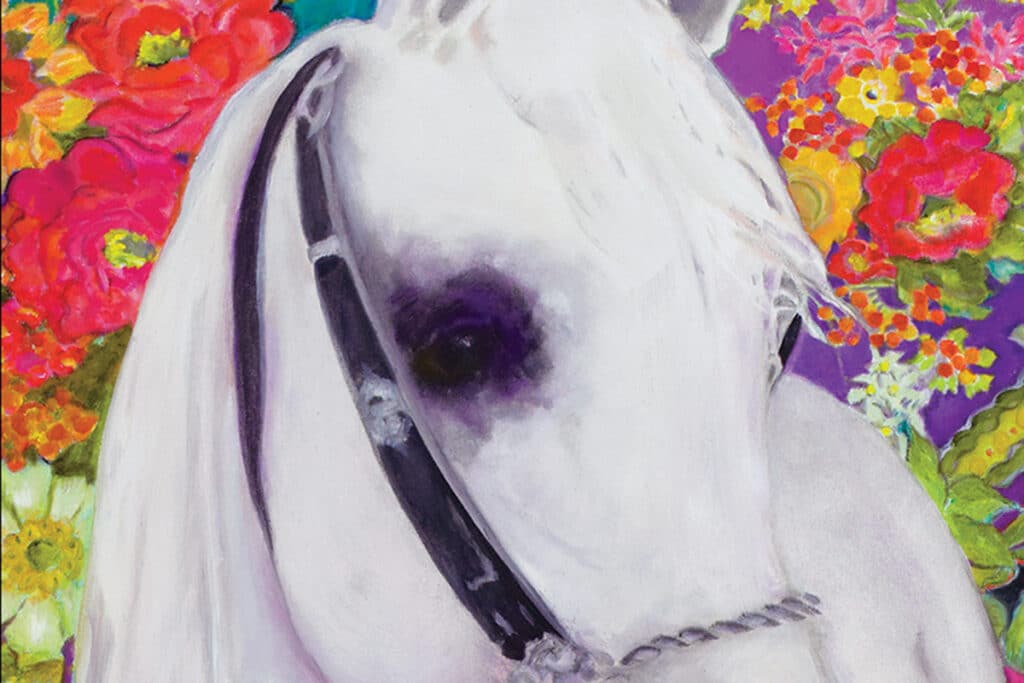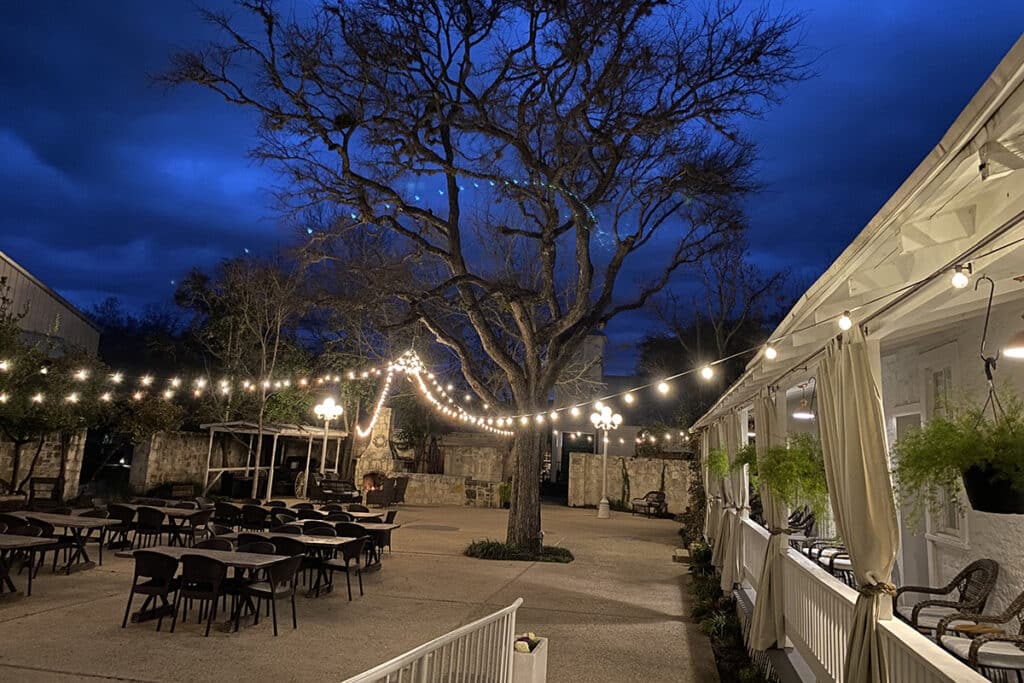Gini Garcia and her crew like to play with fire. In fact, that’s how they make their living. Every day from 5 a.m. to 2 p.m., they can be found in Garcia’s glassblowing studio on South Alamo, where three furnaces glow orange, and the heat is nearly unbearable despite the ventilation.
On this particular day, they are making an orange-and-blue cylindrical vase. Wielding a hollow blow pipe, master glassblower Gerardo Mu96oz repeatedly gathers molten glass out of the largest furnace, rolls it over a special surface to slightly cool the “skin” of the emerging object, and then shapes it by blowing and spinning the hot glass.
Garcia, who designed the vase, and assistant Shara Funari are helping at every step. As they repeat the procedure over and over, the vase grows more and more transparent, the colors more visible. It’s hard physical work in an atmosphere reminiscent of a ship’s boiler room, but the artist/owner doesn’t mind.
“I am used to it,” she says simply, her face shining with perspiration as we finally step into the gallery next door, where her creations are displayed in their cool, resplendent beauty. Several large vessels, looking like upside-down bells, are gathered together on a counter by the door. Ordered by UTSA, they will serve as centerpieces for a scholarship award dinner, she explains. Their colors and speckled appearance have been chosen to represent the Texas springtime landscape.
In the adjacent room, she shows us two large decorative platters made at the request of the city manager’s office. Both have a blue ribbon “flowing” through the middle, this time to symbolize the San Antonio River. These are special orders, but there are plenty of other eye-catching objets d’art all around, including a Chihuly-like chandelier priced at $4,500. With sunlight setting the glassware on fire, the sight is a feast for the eyes.
Garcia founded Garcia Art Glass Inc. in 1998 and has seen her business and reputation grow steadily each year. Today, 80 percent of the studio’s output is commissioned work for clients in San Antonio and beyond. The most popular are light fixtures, which range from the more or less traditional to graphically elegant, contemporary designs that make a strong visual statement.
A couple of years ago, Garcia spent six weeks in Murano, the historical center of Venetian glassmaking, where she explored the challenge of creating chandeliers “for the new millennium.” For her class project, she drew inspiration from a mental image of dancing angels. Translated into glass, it took the form of a chandelier dripping with dozens of ballet slippers with lights inside them.
Among Garcia’s most visible projects are the 180 light fixtures that adorn the AT&T Center’s concession stands; her organ glass sculptures for the Blood and Tissue Center and the TexSan Heart Hospital (complete with pulsating, changing lights); and the decorative installations inside Las Ramblas restaurant in the Hotel Contessa downtown. Her studio also shipped 150 glass pumpkins to London for the premiere of a Harry Potter movie. Garcia’s handiwork also illuminates many offices and private homes.
What makes her work unique, she says, is that each design is site-specific. “I design for the environment,” she says. “I go and see the client’s house or office, or they send me samples of their wallpaper or the fabrics they have in the room. I like to see their favorite colors, their favorite artworks. And, of course, discuss their expectations. In my mind, I create to evoke a certain feeling in the space.”
Another unique feature is that Garcia Glass combines traditional glassblowing techniques with American art glassmaking. There are literally dozens of different methods that can be used to achieve a variety of imagined effects. To create the orange and blue vase that I saw earlier in the “hot shop” — as the studio is called by the pros — the team has to make a series of glass doughnuts, half of them blue and half orange, and then stack and fuse them together to form a vase.
The fascinating part is how the colored patterns are achieved. To begin with, colors are incorporated by rolling the hot “bubble” of clear glass over crushed pigmented glass chips. The emerging object is spun or blown into shape and slightly reheated to keep the material malleable. Then the artist “paints” a pattern through the still hot mass, using a pipe.
“You can swirl it, move it this way or that. We use the pipe like a painter would use the brush,” explains Garcia. “The way you apply color allows you to layer it like in a painting.” In this particular case, the artist was experimenting with ways to produce a seamless colored stripe in each doughnut, apparently something that’s difficult to achieve. It took about one hour to complete the project.
Last year alone, the studio produced 10,000 pieces, including less glamorous ones such as hundreds of paperweights ordered for various conference attendees. Each is “like a business card,” says the artist. They attract new clients, some from as far away as Europe and Brazil. Even those paperweights are all handmade and thus at least somewhat different from each other.
As if to underline her words, Mayor Phil Hardberger calls in the middle of our interview to thank her for a paperweight she presented him earlier in the day. As an advisory board member on the Main Plaza project, Garcia gave Hardberger her gift during a meeting in his office. She chats amiably, obviously pleased by the call.
No second thoughts
Born Maria Eugenia Garcia in Monterrey, Mexico, Garcia came to the United States as a child and grew up in San Antonio. Her first career choice was health care, so she attended UTSA and St. Mary’s University as a pre-med student.
“I didn’t discover art until I was 25,” she says. After taking art classes at San Antonio College, she enrolled in the prestigious Kansas City Art Institute and earned a degree in industrial design.
“I enjoyed the science of product design. There is a lot you need to know in order to design products because they must be functional as well as aesthetically appealing. That’s kind of what I am doing now, too — designing products. I design around a need,” she explains.
But it took several more years before she found her true calling. It was during a visit to New Orleans that she went to an art opening where glassblowers were demonstrating their craft. There was an immediate connection.
“I came back, closed my graphic design business and started going to school to learn glassblowing. Just like that. No second thoughts. I love glass, the color, the fluidity. In my graphic work I always worked to make things organic, fluid. So, when I saw it done so effectively with glass, it seemed like the perfect fit,” she explains.
Many courses and workshops later, she ventured out on her own, first in Boerne and later at her present location on South Alamo. Her family also owns the adjacent building housing the popular Azuca restaurant. The small complex is a “destination,” she says, offering multiple activities.
Besides eating and browsing through the gallery, visitors can also watch the magic of glassblowing in the hot shop. Pretty soon, the 11-person operation will be expanding further to meet the demands of the marketplace.
“I would like to do $1 million in sales by the time I am 45,” says the 42-year-old artist cheerfully. “It should be a result of good work. We are not really money driven.”
That lighthearted comment doesn’t sit well with her mom, who is in charge of running the business side of things. But what’s wrong with dreaming big? This is a woman who is clearly not intimidated by new challenges. Her studio is her life. Single, with no children, Garcia lives nearby and arrives at work at 5:30 a.m., staying until 7 p.m. “I don’t think much about (marriage and children). I have a furnace to take care of,” she jokes.
While we are talking, we are repeatedly interrupted by customers. One of them, computer hardware designer Herb Stunberg, has been at the gallery many times. In fact, he and his wife own about 20 Garcia pieces.
“Everything that Gini makes, makes you happy when you look at it,” he says as he is preparing to buy the aforementioned chandelier. Needless to say, it will have to be carefully packed and delivered.
With such fragile merchandise, mishaps have been known to occur. On one occasion, Garcia and an assistant were installing a special set of decorative platters for an event at the Central Library when disaster struck. The platters were supposed to hang from a cable stretched across the length of a wall. She was standing right under the installation when the cable broke and the whole thing came crashing down. “He (the assistant) turned white because he saw the cable break, and we just embraced, speechlessly. Then we had to remake 20 platters in two days to get them ready for the event. Things break; it’s glass,” she says.
Her medium may be fragile, but its appeal is immediate and universal. People simply respond to beautifully shaped glass even when it’s factory made, and especially when it’s a handmade original artwork. Does she have any thoughts on that?
“It’s what light does to glass,” she says. “Glass is a filter that can create many different effects when the light shines on it. We can manipulate the surface of the glass to change the way the light is filtered. It’s also the fluid nature of glass that reminds us of water, its shiny, sparkly lure.”
Garcia Art Glass, 715 S. Alamo, sells handmade original pieces ranging in price from $22 Christmas ornaments to chandeliers costing up to $7,000. The gallery will have a sale Nov. 17-18.
Author: Jasmina Wellinghoff
Photographer: Janet Rogers




